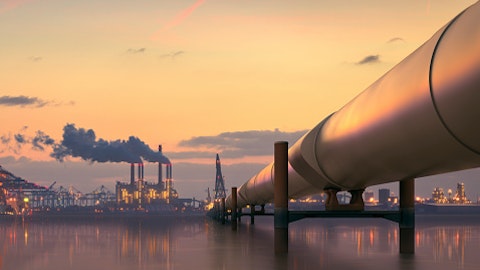DT Midstream, Inc. (NYSE:DTM) Q4 2023 Earnings Call Transcript February 16, 2024
DT Midstream, Inc. isn’t one of the 30 most popular stocks among hedge funds at the end of the third quarter (see the details here).
Operator: Good morning. My name is Audra and I will be your conference operator today. At this time, I would like to welcome everyone to the DT Midstream Fourth Quarter 2023 Earnings Conference Call. Today’s conference is being recorded. All lines have been placed on mute to prevent any background noise. After the speaker’s remarks, there will be a question-and-answer session. [Operator Instructions] At this time, I would like to turn the conference over to Todd Lohrmann, Director of Investor Relations.
Todd Lohrmann: Good morning, and welcome everyone. Before we get started, I would like to remind you to read the safe harbor statement on Page 2 of the presentation, including the reference to forward-looking statements. Our presentation also includes references to non-GAAP financial measures. Please refer to the reconciliations to GAAP contained in the appendix. Joining me this morning are David Slater, President and CEO; and Jeff Jewell, Executive Vice President and CFO. I’ll now turn it over to David to start the call.

David Slater: Thanks, Todd, and good morning, everyone, and thank you for joining. During today’s call, I’ll discuss our 2023 accomplishments and provide an update on our organic growth projects and future outlook. I’ll then close with some remarks on the accomplishments the DTM team has made since we spun the company in 2021, before turning it over to Jeff to review our financial performance and outlook. So with that, 2023 ended strong. We delivered full year adjusted EBITDA of $924 million, which exceeded our guidance midpoint and represents 10% growth year-over-year. We also executed on the largest construction program in our company’s history. And I’d like to thank the team for successfully completing these projects ahead of schedule and on budget.
I’d also like to commend the team for their excellent safety performance. We finished the year with only one OSHA recordable, one of our best safety years on record. Most notably, we placed our LEAP Phase I and II expansions in service early, which are fully contracted and directly served a growing LNG markets along the Gulf Coast. With these expansions completed, we’re able to focus construction activities on Phase III, which is currently running ahead of schedule. On Blue Union, we added additional treating and pipeline capacity. Putting us in an advantaged position to quickly ramp supply to serve the coming LNG demand wave beginning in 2025. Turning to the Northeast. We successfully completed our Appalachia gathering system Phase 2 expansion which added additional mainline capacity.
In Ohio, our Ohio Utica project trunk line was completed early and we began collecting revenue under our take-or-pay agreement. On NEXUS, we’re able to sell new capacity through hydraulic optimization initiatives. Throughout the year, our business team successfully executed several new commercial agreements, including our Ohio Utica project, a new supply interconnect on Blue Union in the Carthage area and then interconnect with the Gillis Access project on LEAP. Additionally during the fourth quarter, we finalized new agreements that will result in a Phase III expansion to our Appalachian gathering system and expansion of the Tioga gathering system and a pipeline expansion on the Blue Union system. The business development team remains focused progressing our deep organic project backlog, which currently sits at over $1.3 billion through 2027.
See also 20 Fastest Growing E-Commerce Companies in 2024 and 15 Best Hospitals for Cancer Treatment in the US.
Q&A Session
Follow Dt Midstream Inc.
Follow Dt Midstream Inc.
On LEAP, we are in advanced discussions for a Phase IV expansion which we are now estimating to be between 200 million and 400 million cubic feet a day. We have also updated our expansion potential on the LEAP system from 3 Bcf a day to 4 Bcf a day. This asset is fully integrated into the Haynesville supply region, operating today and easily expandable. It provides superior market access and connectivity to the Gulf Coast LNG corridor. LEAP offers tremendous value to our current and future customers, and we feel confident in our ability to gain additional market share. Regarding the LNG permitting pause announced by the Biden administration, we see no material impact to our business in the near term. All LNG demand growth, which will be directly served via LEAP is fully permitted and under construction.
We continue to view the U.S. Gulf Coast as the premier LNG export region and a critical supply source for our European and international allies. Energy security for allies will remain a long-term geopolitical priority for the U.S. Additionally, LNG is the largest, most cost effective and reliable solution to reduce carbon emissions internationally by displacing coal and supporting the build-out of intermittent renewable energy. Our assets are well positioned to support these long-term energy fundamentals and priorities. I’d now like to provide an update on our carbon capture and storage project in Louisiana. In early January, we received our Class 5 well permit, and we are currently drilling a characterization well to confirm our favorable view on the geology of our storage site.
Throughout the project, our development approach has been methodical, leveraging our extensive storage pipeline and tax credit expertise. Our goal is to minimize our capital at risk, while systematically derisking our CO2 storage site for reaching a final investment decision. We have been closely collaborating with Louisiana D&R, local geology experts, and actively engaged in community outreach. Adhering to our disciplined development philosophy, we are pursuing a phased approach to this project. Phase I will include installing capture equipment and compression at our Southernmost treating plant and constructing a dedicated CO2 pipeline to transport captured CO2 to our storage site. We expect Phase I to go on service in the second half of 2026.
Phase II will capture CO2 from a second DT Midstream treating plant and is expected to be in service in 2027. As a reminder, the 45(2) tax credit will provide their revenue streams for the project. Finally, I want to take a moment to reflect on the achievements the DTM team has made since we spun the company. It’s been a very exciting three years. Since the spin-off, we’ve achieved significant growth while maintaining a high quality pure-play natural gas asset portfolio. We have delivered 9% annual adjusted EBITDA growth which has outpaced gas focused midstream peers. We have also consistently grown the dividend, including today’s announced increase of 7%. Driving this growth has been our high quality natural gas pipeline segment, which represented less than 50% of our business mix at spin and has grown to represent about two-thirds of our business today, ranking DTM as having the highest natural gas pipeline segment mix in the peer group.
Our portfolio continues to be well contracted with a high level of take or pay agreements and an average contract tenure of nine years. The same contract tender is when we spun the company in 2021. We also have no direct commodity exposure, a unique feature among our peer group. Our integrated wellhead to market pipeline asset portfolio is positioned to serve growing demand markets from two world-class dry gas basins and features a deep organic growth project backlog that is grounded in supportive long-term market fundamentals. One of our goals from the onset of the spin was to achieve an investment grade credit rating, and we are in a very strong position to achieve that this year. We have maintained a strong balance sheet and financial flexibility with our current leverage in a very comfortable position.
Our ESG program has also made great strides since the spin and is in a very strong position today. We have improved our MSCI rating two notches with our current rating at AA, the second highest rating possible. This positions DTM as having a best-in-class rating. Our safety total recordable incident rate has consistently improved each year for a cumulative 83% improvement since spin. Our community giving and volunteer hours on a per employee basis is leading among our sector peers. All of these great accomplishments could not have been achieved without the hard work and dedication from our individual team members who have continued to demonstrate excellent performance and professionalism. Additionally, the team’s unwavering commitment to customer service sets them apart, consistently delivering customer satisfaction and fostering strong relationships.
A distinction that has been independently recognized as best-in-class within the sector, where we received the top ranking in the MASTIO Customer Service Study of midstream companies. In summary, I am very proud of the DTM team. Their dedication to delivering exceptional results for our shareholders, customers and communities is foundational to our business performance and future success. It is an honor to work with this group, and I truly look forward to what the future has in store for the company. I’ll now pass it over to Jeff to walk you through our financial results and outlook.
Jeffrey Jewell: Thanks, David, and good morning, everyone. As David mentioned, we delivered overall 2023 adjusted EBITDA of $924 million, which is up 10% over the prior year driven by our pipeline segment. For the fourth quarter, we delivered overall adjusted EBITDA of $239 million, which was an increase of $3 million over the third quarter. Reviewing our segment quarterly results. Our Pipeline segment was up $11 million over the prior quarter, driven by the early in service of our LEAP expansions, higher revenues at our pipeline joint ventures and increased rates on new contracts at our Washington 10 storage facility. Our Gathering segment results were $8 million lower than the prior quarter, due to a $6 million environmental reserve adjustment recognized in the third quarter, and modestly lower volumes in the Haynesville partially offset by higher volumes in the Northeast.




